AI in Risk-Based Pest Control Systems
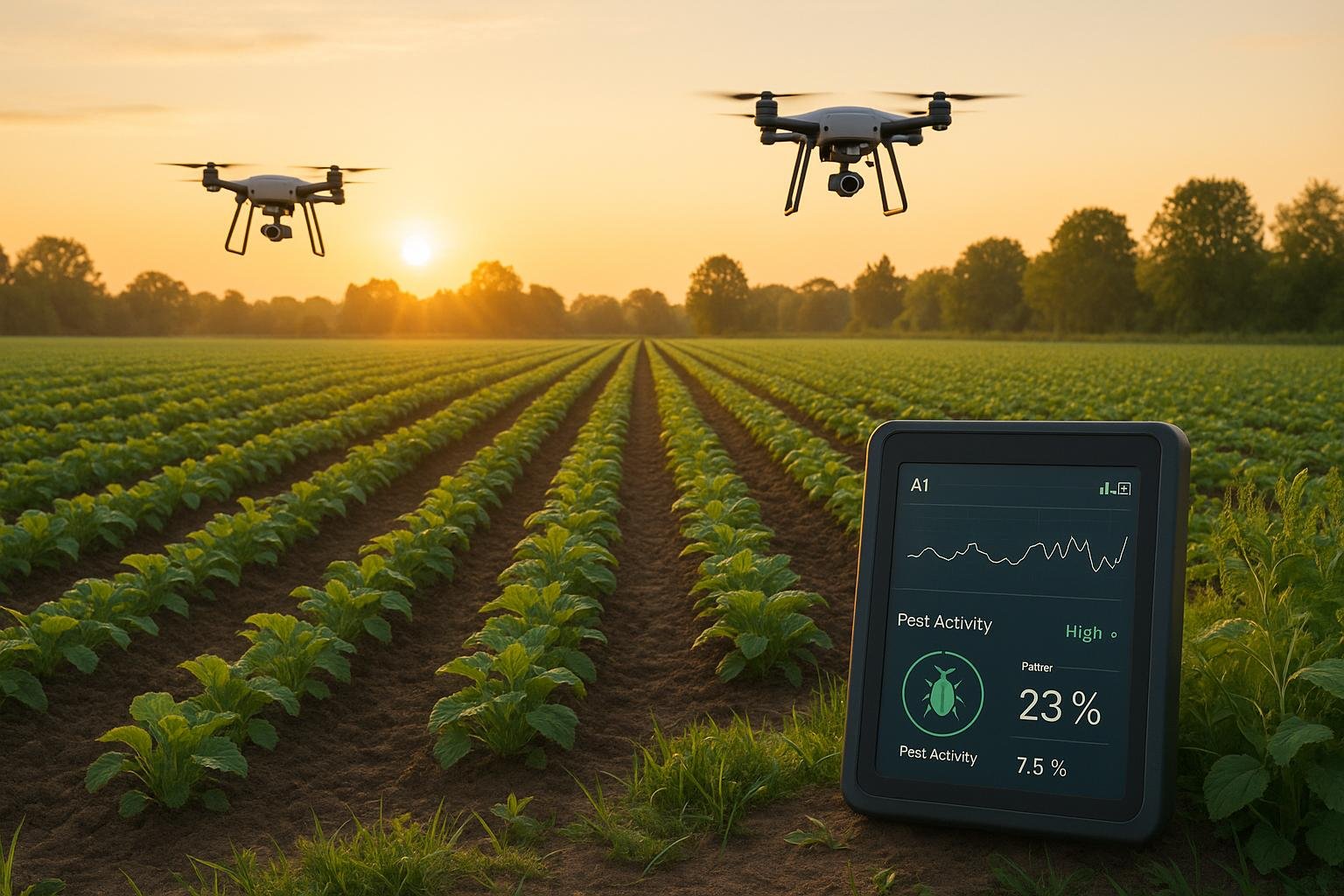
AI is reshaping pest control by using data and automation to predict, monitor, and manage pests. Unlike older methods that relied heavily on chemicals, AI enables precise, targeted interventions, reducing pesticide use by up to 90% in some cases. It’s already helping farmers save time, cut costs, and improve yields while supporting healthier ecosystems. Home gardeners and landscapers can now access similar tools, benefiting from early pest detection and tailored solutions.
Key takeaways:
- AI tools like smart sensors, computer vision, and machine learning predict and detect pests with high accuracy.
- Farmers report up to 20% yield increases and reduced crop losses.
- Home users gain access to affordable, user-friendly apps and devices for pest control.
- Challenges include high costs for advanced systems and the need for diverse, high-quality datasets.
AI-powered pest management is making pest control faster, more efficient, and accessible for both large-scale farms and home gardens.
Role of Artificial Intelligence in Pest Management

Key AI Technologies for Pest Control
AI technologies play a pivotal role in identifying pests, forecasting outbreaks, and monitoring gardens in real time. Let's explore three major technologies - machine learning, computer vision, and smart sensors - that are reshaping pest control methods.
Machine Learning for Pest Prediction
Machine learning is at the heart of proactive pest management, offering the ability to predict outbreaks and issue early warnings. Unlike traditional manual techniques, machine learning automates the detection, classification, and pinpointing of pests, streamlining the entire process [4]. Studies have shown classification accuracies ranging from 82% to 93% by leveraging various machine learning algorithms and data augmentation techniques [4][5].
These algorithms are particularly efficient, requiring less data, shorter training times, and reduced computational power compared to deep learning methods [5]. For example, researchers have created an insect-plant dataset featuring pests like the Colorado potato beetle, green peach aphid, and seven-spot ladybird, focusing on crops such as potatoes, faba beans, and sugar beets. By incorporating explainable AI for feature selection, they developed a model with improved accuracy while minimizing parameters and memory usage [5]. Techniques like balancing datasets and applying data augmentation further enhance the model's ability to perform well under diverse conditions [4].
Computer Vision for Pest Detection
Computer vision systems, powered by cameras and image recognition, can automatically identify pests, often detecting issues faster than human inspections. Frameworks like YOLO (You Only Look Once) have achieved detection accuracies exceeding 76% and processing speeds between 16–29 frames per second (fps) on various devices [6].
One notable study developed an insect monitoring system using a simple RGB camera paired with deep-learning models to identify stored product insects in warehouses, food facilities, and retail spaces. The researchers compiled a dataset of 2,630 images with 14,509 labeled instances, featuring six common insect species [6]. The YOLOv8l model emerged as the top performer, achieving detection speeds of 16 fps on a desktop and 29 fps on a smartphone [6]. Such advancements make computer vision a practical tool for both industrial and small-scale pest management.
Smart Sensors and Connected Traps
Smart sensors and internet-connected traps bring continuous monitoring to pest control, offering real-time data on pest activity and environmental conditions. These devices enable precise, targeted interventions, significantly reducing the need for broad-spectrum pesticides while cutting down on human labor and potential errors [8].
The market for smart pest monitoring is projected to grow substantially, reaching $1,219.35 million by 2028 [7]. These systems improve detection accuracy by 35% and reduce response times by 40%, providing instant notifications and enabling timely action [7][8]. AI-driven pest control systems now boast identification accuracies exceeding 96% [7].
One standout example is the SmartProbe, which exemplifies the potential of connected monitoring. According to UC Davis researcher Zhongli Pan:
The SmartProbe remotely monitors the activities of insects and alerts managers of storage and processing facilities to take proper actions for controlling the insects. It also monitors the temperature and relative humidity of stored products [7].
For home gardeners and landscapers, placing smart sensors strategically - such as in attics, near doorways, or in areas prone to moisture - ensures effective monitoring [7]. These systems can be tailored with detection thresholds based on factors like economic impact, health and safety, legal requirements, or aesthetic concerns. Additionally, many smart pest control devices now integrate with broader smart home ecosystems, letting users track pest activity alongside other home automation features [7]. Unlike traditional traps requiring manual checks, modern smart traps send instant alerts when pests are detected, allowing for quicker responses and potentially reducing the need for heavy chemical treatments [8]. This level of connectivity benefits both large-scale operations and individual homeowners, offering timely and actionable insights for effective pest control.
Research Results and Case Studies
These case studies, rooted in risk-based pest control principles, showcase how AI is reshaping agriculture and home gardening by delivering precise, measurable results. Research confirms that AI is turning traditional pest management into a data-driven process, saving time, money, and crops with impressive efficiency.
Improved Pest Detection Speed and Accuracy
AI systems are proving to be faster and more accurate than traditional pest detection methods. For example, the Tamil Nadu Agricultural University (TNAU) developed an Android app using deep convolutional neural networks to detect fall armyworm in maize crops. This app achieved a validation accuracy of 93.47% and a training accuracy of 98.47% [11].
In greenhouse environments, computer vision models like YOLOv5 have shown remarkable results, identifying pests such as leaf miners, fruit flies, aphids, whiteflies, house flies, and thrips with 96% accuracy [11]. Similarly, a multilayer perceptron model using acoustic sensors reached an incredible 99.78% accuracy in identifying 800 pest species, with specificity and sensitivity rates of 99.64% and 99.91%, respectively, outperforming other deep learning alternatives [11].
Globally, insect pests are responsible for 30-40% of annual crop losses, while plant diseases cost the economy over $220 billion annually, with pests adding another $70 billion to the toll [10][11]. These advancements in AI highlight its potential to mitigate such staggering losses.
Successful AI Pest Control Projects
AI-driven pest control projects have shown tangible success in real-world applications. For instance, Semios, in partnership with Google, reduced moth populations by 1.5 billion in almond orchards, leading to increased production [1]. Blue River Technology's smart sprayers have cut herbicide use by up to 90% while maintaining effectiveness [1].
Trapview has enhanced pheromone traps by using deep learning algorithms to analyze insect images. As CEO Matej Štefančič explained:
We've built the biggest database of pictures of insects in the world, which allows us to really use modern AI-based computing vision most optimally. [10]
Other notable implementations include AgShift's "DeepAgro" platform for crop image analysis, the University of Georgia's "PestID" smartphone app, and FarmSense's monitoring platform for optimizing spray timing against navel orangeworms in nut orchards [11][1]. Cotton farmers, too, are benefiting from AI-powered pest detection combined with pheromone traps, which help manage bollworms while reducing over-spraying and boosting yields [1].
Comparing Different AI Methods
AI methods vary in effectiveness depending on the application and environment. Deep convolutional neural networks (CNNs) excel at automatic feature extraction, often outperforming traditional machine learning approaches [11]. For instance, an enhanced ResNet34 model achieved higher accuracy than AlexNet, ResNet34, and ResNet50 when classifying 15 cotton insect pests. In object detection, Faster R-CNN reached 98.9% accuracy, significantly outpacing SSD MobileNet (86%) and traditional BP neural networks (50%) [11]. Support vector machines also stood out for their reliability in predicting pest occurrences [11].
The table below highlights the performance of various sensors and AI models in pest detection:
| Sensor Type | AI Model | Detection Accuracy | Target Organism |
|---|---|---|---|
| PEN3 e-nose | Back-propagation neural network | 96.67% (insect age) | Brown rice plant hoppers |
| Alpha MOS Fox 3000 | Support vector classifier | 97.67% | Citrus Tristeza Virus |
| Conductive polymer e-nose | VOC fingerprints | 94.4% | Kudzu bugs in soybean |
| 32-sensor array | PCA analysis | 97.8% | Botrytis neck rot and onion sour skin |
In specific tests, SegNet outperformed DCNN and HD-CNN in detecting five cotton pest species, while Faster R-CNN achieved 95.08% accuracy compared to YOLOv4's 71.77% [11]. Camera and microphone-based setups, using advanced deep learning algorithms, demonstrated accuracy rates between 70% and 98%, depending on the scenario [14].
As Danishta Aziz and colleagues noted:
Despite challenges in data quality and technology accessibility, the integration of AI and RS holds significant potential in revolutionizing pest management. [13]
sbb-itb-4d6a8dd
🚀 Ready to Reinvent Your Garden?
Join thousands of homeowners who have transformed their gardens using our AI design tool. Upload one photo to explore endless possibilities.
Get your AI garden designs →Problems and Limits of AI Pest Control
AI pest control systems hold a lot of promise, but implementing them in real-world settings is far from straightforward. They face several hurdles that can compromise performance, drive up costs, and make them less accessible to farmers and gardeners who stand to benefit the most.
Data Quality Issues
AI systems thrive on large, high-quality datasets. Without them, their ability to accurately detect and identify pests takes a hit. Poor data can lead to missed detections or false alarms, wasting both time and money for users. The challenge is that pest behavior is influenced by factors like weather, seasons, and geography, making it hard to build datasets that cover all real-world scenarios. Gathering this kind of diverse data often requires extensive fieldwork, which is both time-consuming and expensive.
On top of that, privacy and regulatory concerns can restrict access to important agricultural data. Information about farm locations, crop yields, and pest infestations is sensitive, and sharing it can create compliance issues. This limits the availability of data for training AI systems, leaving gaps in geographic and environmental coverage.
For instance, a study on cotton insect pests highlighted these challenges. Researchers used a dataset of 100 original images and 620 augmented images for each of 15 insect species. Despite this, convolutional neural network (CNN) models struggled to differentiate visually similar pests like Heliothis virences (adult) and Spodoptera frugiperda (adult) [11].
Developing effective AI pest control systems also requires collaboration across multiple disciplines - computer science, entomology, agriculture, and fieldwork. Each field has its own data collection standards and priorities, which can further complicate the process of ensuring accurate pest identification.
Difficulty Identifying Different Pests
One of the biggest technical challenges for AI systems is distinguishing between pests that look alike. Many insects share similar colors, shapes, and sizes, especially during certain life stages. This can easily lead to misidentifications, which in turn result in incorrect treatments.
Environmental factors like mimicry and camouflage make things even trickier [9]. Misidentifying pests can have serious consequences, such as unnecessary pesticide use, ineffective treatments, and harm to beneficial insect populations [16].
The importance of accurate and timely identification is underscored by research from China, where data from 430 rice fields showed that even a 15–20% delay in pest control significantly increased pesticide use across farming communities [12]. Similarly, studies in sub-Saharan Africa on fall armyworm infestations in maize crops found that early identification and intervention greatly reduced yield losses compared to delayed responses [12].
While some systems show promise, they’re not foolproof. For example, a system developed by a NARO-led consortium achieved over 80% accuracy in identifying major pests for crops like tomatoes, cucumbers, strawberries, and eggplants [17]. However, this still leaves room for errors, which could have real-world consequences for farmers.
Cost and Access Barriers
Beyond technical limitations, the cost of AI pest control systems is a major barrier to widespread adoption. Monthly operating expenses can range from $8,000 to $12,000 [19], making it difficult for smaller farms and operations to afford. Initial setup costs are even steeper, covering areas like:
| Cost Category | Description | Range |
|---|---|---|
| R&D | Developing and testing AI algorithms | $50,000–$150,000 |
| Technology Infrastructure | Hardware, servers, and network systems | $30,000–$100,000 |
| Technical Salaries | Managing and interpreting AI outputs | $200,000–$500,000 |
| Software & Licensing | AI software subscriptions and licenses | $15,000–$40,000 |
On top of these upfront costs, annual maintenance expenses can increase by about 15% [19]. Skilled technicians are also required to manage and interpret AI outputs, which adds another layer of complexity and cost - especially for smaller farms that may lack the resources to hire such expertise [18].
"Data is the backbone of AI." – Inupa Bandara [2]
Geographic and economic disparities make these systems even less accessible for small-scale farmers and those in resource-limited regions [11]. However, there are some strategies to reduce costs. For example, negotiating better software license terms, using open-source AI frameworks, leveraging scalable cloud services, and hiring part-time staff during off-peak seasons could cut operational expenses by up to 20% [19].
While these measures might ease the financial burden, they don’t entirely solve the problem of making AI pest control systems more accessible and practical for everyone.
Future Developments and Uses
The next wave of AI pest control systems is set to tackle existing challenges by integrating smarter data analysis, speeding up processing, and making advanced tools more accessible. These advancements build on prior achievements in AI for pest management, opening the door to innovative applications.
Combining Multiple Data Sources
Future AI systems will bring together information from weather, soil, plant health, and pest activity to create highly accurate predictions. Instead of relying on isolated data points, these systems will analyze how various factors interact, offering a more complete picture of pest behavior and crop conditions.
A great example of this approach is FarmSense. Their pest-monitoring platform collects real-time insect and environmental data directly from the field and processes it using AI. By learning the specifics of each grower's environment - like crop type, weather patterns, and terrain - the system provides tailored recommendations, such as the best timing for spraying against pests like navel orangeworms in nut orchards [1].
Researchers are taking this concept even further. Some teams have developed deep learning models that combine data from weather stations, soil moisture sensors, and pest traps to predict infestations in vineyards [11]. These machine learning algorithms can detect vegetation abnormalities and warn users about potential pest issues before any visible damage occurs. By factoring in weather trends, crop cycles, and pest life stages, these systems deliver precise predictions that allow timely, effective interventions [15].
This level of data integration also supports more eco-friendly practices. For instance, AI systems can assess crop health, track pest movement, and evaluate environmental conditions to reduce pesticide usage while still maintaining control [15]. They can even combine different strategies, like biological controls and farming techniques, to suggest the most sustainable pest management solutions [15].
Local Processing for Instant Decisions
Speed is key when it comes to pest control, and local processing technology is making real-time responses possible. With edge computing, AI systems can analyze data directly on smart devices rather than relying on remote servers. This eliminates delays caused by internet connectivity, allowing for immediate threat assessments and recommendations.
Recent research highlights the potential of these systems. In May 2025, a Transformer–ConvLSTM model demonstrated 94.5% accuracy at 52 frames per second (fps) [20]. It could also adjust its processing complexity based on available resources, making it a versatile option for a variety of devices.
Another milestone came in July 2025 with the introduction of Tiny-LiteNet, a lightweight AI model designed for portable devices. This model achieved an impressive 98.6% accuracy with a compact size of just 1.2 MB and an inference time of 80 milliseconds [21]. It outperformed traditional deep learning models while requiring fewer resources, making it ideal for small-scale applications. Affordable platforms like the Raspberry Pi 5 are also stepping up, offering high-accuracy, low-latency solutions for deploying these lightweight models in settings with limited resources [21].
Thanks to these advancements, gardeners and farmers can now access instant pest identification and treatment advice without depending on cloud processing or stable internet connections.
AI Pest Control for Home Gardens
AI-driven pest management tools are no longer limited to large-scale farms; they’re becoming accessible to home gardeners and small-scale growers through mobile apps and easy-to-use platforms. This shift makes advanced pest control tools available for personal garden care, aligning with the broader goal of accessible, risk-based pest management.
For instance, Penn State University’s Plant Village app offers resources to help users manage plant diseases and pests, while the University of Georgia’s PestID app uses AI to identify pests from smartphone photos [11]. The Food and Agriculture Organization’s PestNet app takes a community-based approach, enabling users to share photos of pests and diseases for expert identification [11].
For home gardeners, AI pest detection offers clear advantages over traditional methods:
| Detection Method | Detection Speed | Accuracy Rate | Labor Hours per Acre | Potential Yield Improvement |
|---|---|---|---|---|
| Traditional Scouting | 5–14 days | 70–75% | 4–8 hours | 5–10% |
| AI Pest Detection | Same day | 92–97% | <0.5 hours | 15–25%+ |
Platforms like AIGardenPlanner are already integrating these pest control features into their garden design tools. By combining AI-powered garden planning with pest management capabilities, users can receive tailored advice on plant choices and pest prevention strategies based on their location, climate, and garden conditions.
Small-scale urban farmers also stand to benefit. AI-based apps provide real-time insights into weather, pest threats, and plant health [22]. These tools often suggest organic treatments and targeted interventions, helping reduce pesticide use by as much as 90% through precise application techniques [3].
As AI technology becomes more commonplace, costs are dropping, making these tools affordable for everyday gardeners. Lightweight AI models paired with cloud-based insights offer an effective, budget-friendly solution that rivals professional agricultural systems.
The Future of AI in Pest Control
The future of pest control is set to be reshaped by advancements in AI technology. From commercial farms to backyard gardens, AI is revolutionizing how pests are detected, managed, and eradicated - all while cutting costs. By 2025, AI revenue is projected to surpass $36 billion globally, underscoring its growing economic influence [24].
One of the most exciting developments is AI's ability to boost the speed and accuracy of pest detection. For example, AI systems have been shown to identify pests like red imported fire ants with over 90% accuracy [27]. These capabilities allow for faster responses and more targeted interventions, reducing both time and expense.
Industry leaders are already embracing AI across various tasks. Todd Leyse of Adam's Pest Control Inc. highlights how AI is being used for everything from creating content to real-time transcription [26]. Meanwhile, platforms like AIGardenPlanner are making plant identification a breeze, offering instant species recognition and care instructions [23]. As these technologies advance, they promise to become even more accessible and cost-effective, aligning perfectly with the proactive, risk-based strategies gaining traction in pest management.
Smart sensors and AI-powered traps are another game-changer. These tools not only improve detection accuracy but also minimize pesticide use. For instance, Blue River Technology's smart sprayer uses image-based targeting to reduce herbicide application by up to 90% [1][25].
"I believe AI is the next business decision everyone needs to make. Business owners should look into what AI can do for them and get on the bus, or else they will get run over."
– Jeff King, president of The Pest Rangers [26]
Mobile apps are also playing a crucial role, offering instant pest identification and treatment recommendations. This is especially important in areas with limited resources, where quick solutions can help combat the staggering 30–40% annual crop losses caused by insect pests, as reported by the FAO [11][28].
As AI continues to evolve, its contributions to pest control will only grow, benefiting large-scale agriculture and home gardening alike. These advancements will not only make pest management more efficient but also promote sustainable practices for a healthier planet.
FAQs
What are the advantages of using AI-powered pest control systems for small-scale farmers and home gardeners?
AI-powered pest control systems bring a major advantage by enabling early pest detection, giving small-scale farmers and home gardeners the chance to respond promptly with focused solutions. This approach can slash pesticide usage by as much as 90%, significantly lowering costs and minimizing harm to the environment.
Unlike traditional methods that often depend on manual inspections or blanket pesticide applications, AI systems deliver real-time insights for more accurate pest control. This not only boosts efficiency but also promotes eco-friendly gardening, making these tools especially useful for smaller farms and personal gardens.
What challenges do AI-driven pest control systems face, and how can they be addressed?
AI-powered pest control systems come with their fair share of challenges. For starters, high upfront costs can be a significant barrier. Then there’s the issue of data quality and privacy, which raises concerns about how information is collected, stored, and used. On top of that, many existing systems rely on outdated infrastructure, making it tough to integrate new technologies seamlessly. And let’s not forget the hurdles of meeting regulatory requirements and gaining the trust of consumers - both crucial for broader acceptance.
Addressing these challenges requires a multi-faceted approach. Investing in updated infrastructure is a key step, ensuring systems can handle modern AI technologies. At the same time, focusing on secure, accurate data practices can alleviate privacy concerns. Partnering with AI experts to develop customized solutions can also make a big difference. Finally, open and transparent communication about the advantages and safety of these systems is essential to build trust and encourage smoother adoption.
How do AI systems use data to enhance pest prediction and control strategies?
AI systems are transforming pest prediction and control by pulling together data from various sources like weather trends, pest life cycles, sensor readings, and imagery. Through advanced machine learning models, these systems break down the data to identify early warning signs, locate high-risk zones, and predict potential outbreaks with remarkable precision.
This method enables precise and timely interventions, cutting down on the need for widespread pest control efforts and boosting overall efficiency. With AI in the mix, pest management becomes sharper, more efficient, and tailored to specific conditions.
🎨 Visualize Your Dream Garden Today!
Transform any outdoor space into a professional landscape design in minutes. Just upload a photo, choose your style, and let our AI do the rest.
Start your garden transformation now →Related posts
Related Articles

Designing the Perfect Layout for Your Vegetable Garden in Raised Beds
Learn how to design and plan the perfect layout for your vegetable garden in raised beds. Get tips for site selection, designing the layout, planting and maintenance.
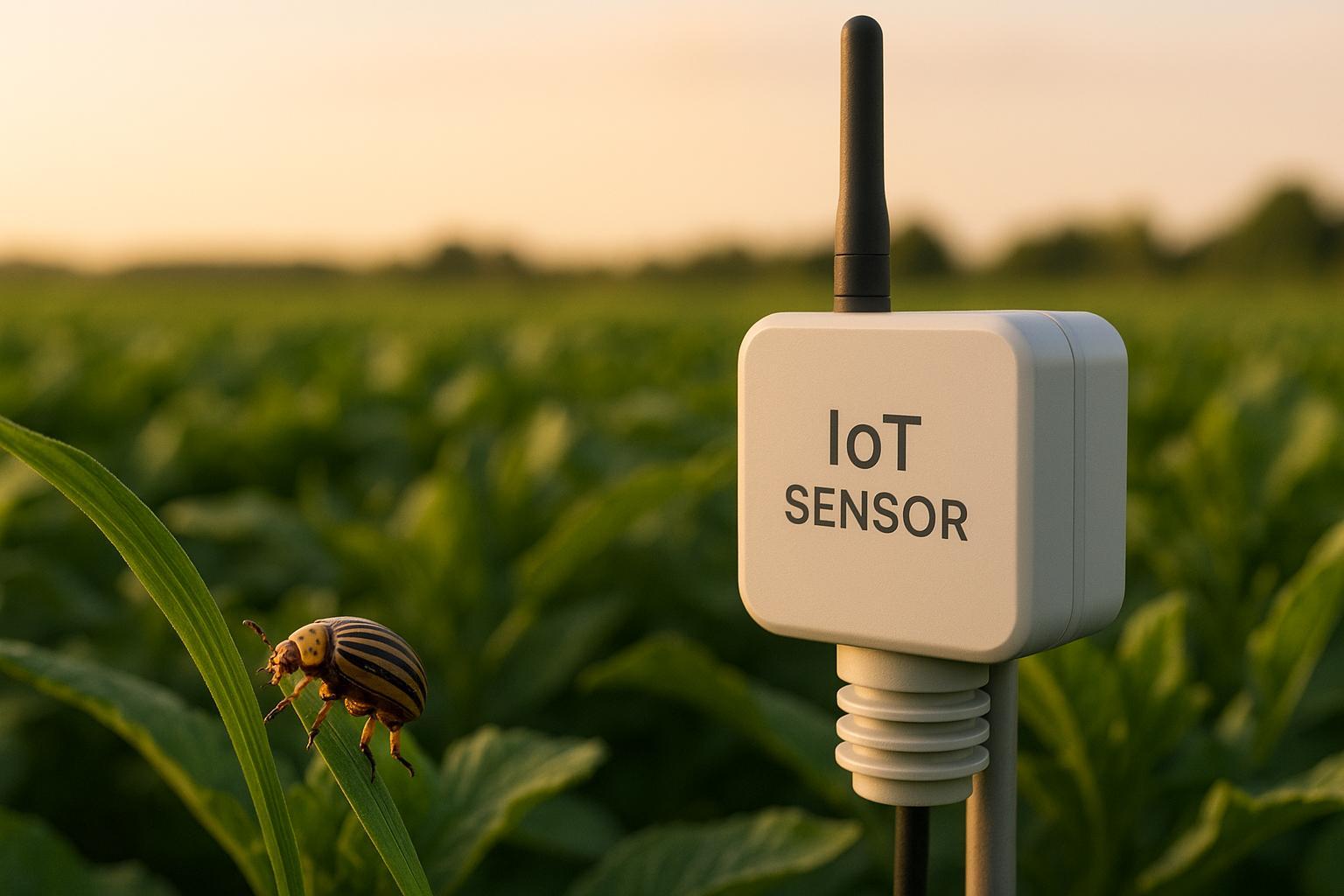
How IoT Sensors Transmit Pest Data
Explore how IoT sensors revolutionize pest monitoring through real-time data and automation, enhancing crop management and reducing pesticide use.
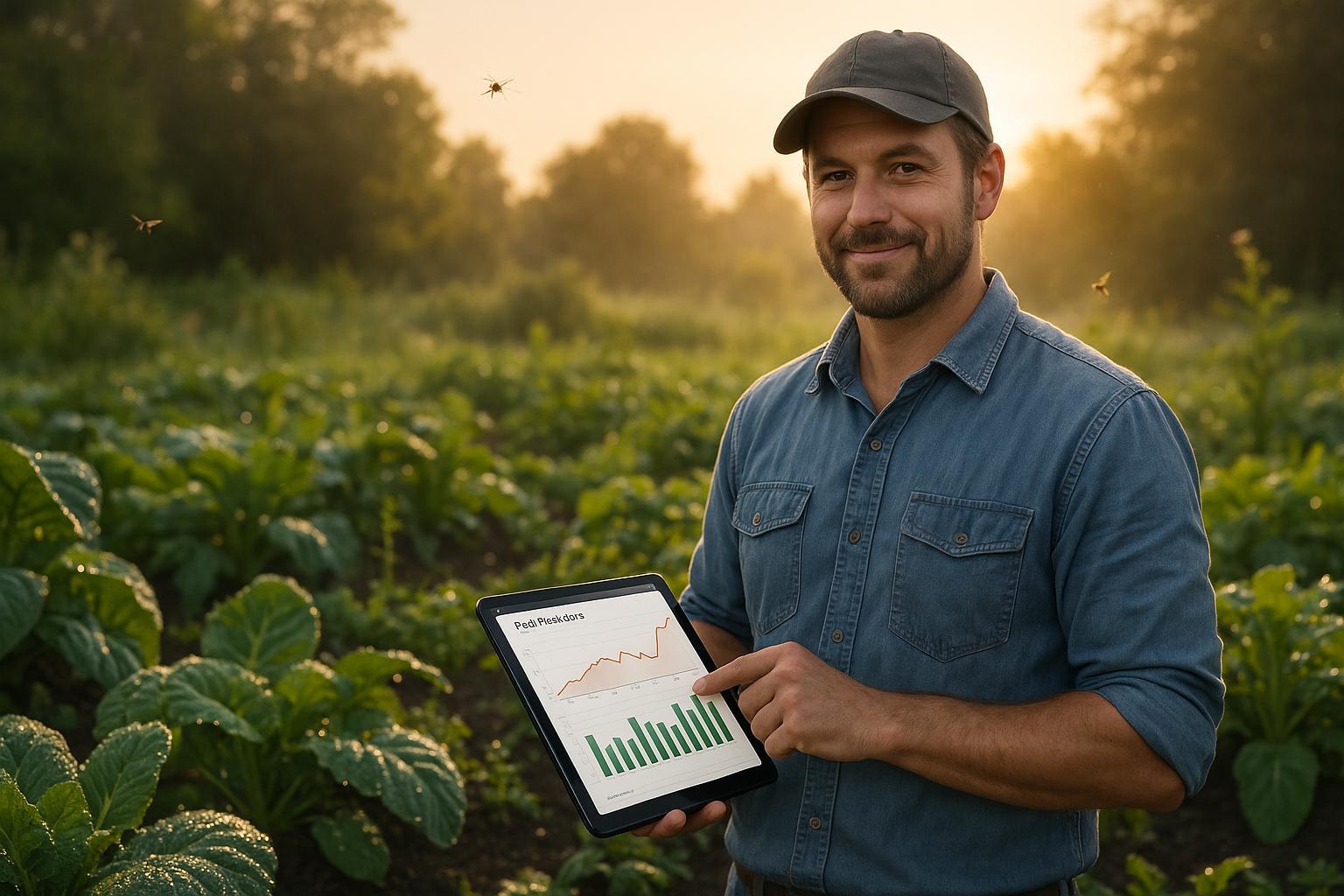
FAQs on AI Pest Prediction Models
Explore how AI pest prediction models revolutionize pest management, offering early detection, reduced pesticide use, and proactive gardening solutions.
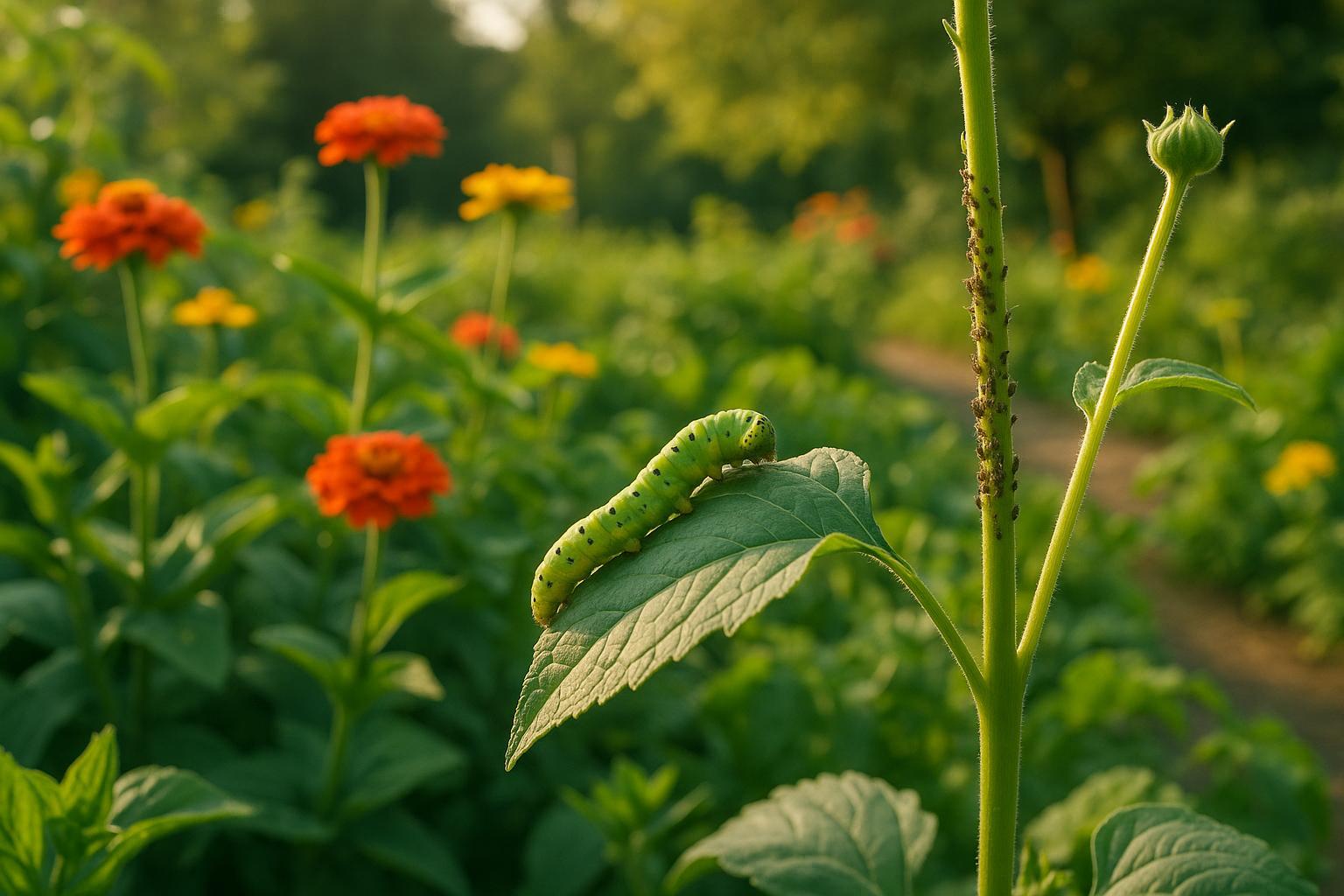
How Climate Affects Pest Risks in Gardens
Climate change is altering pest behaviors, leading to increased risks in gardens. Learn how to adapt and manage these challenges effectively.
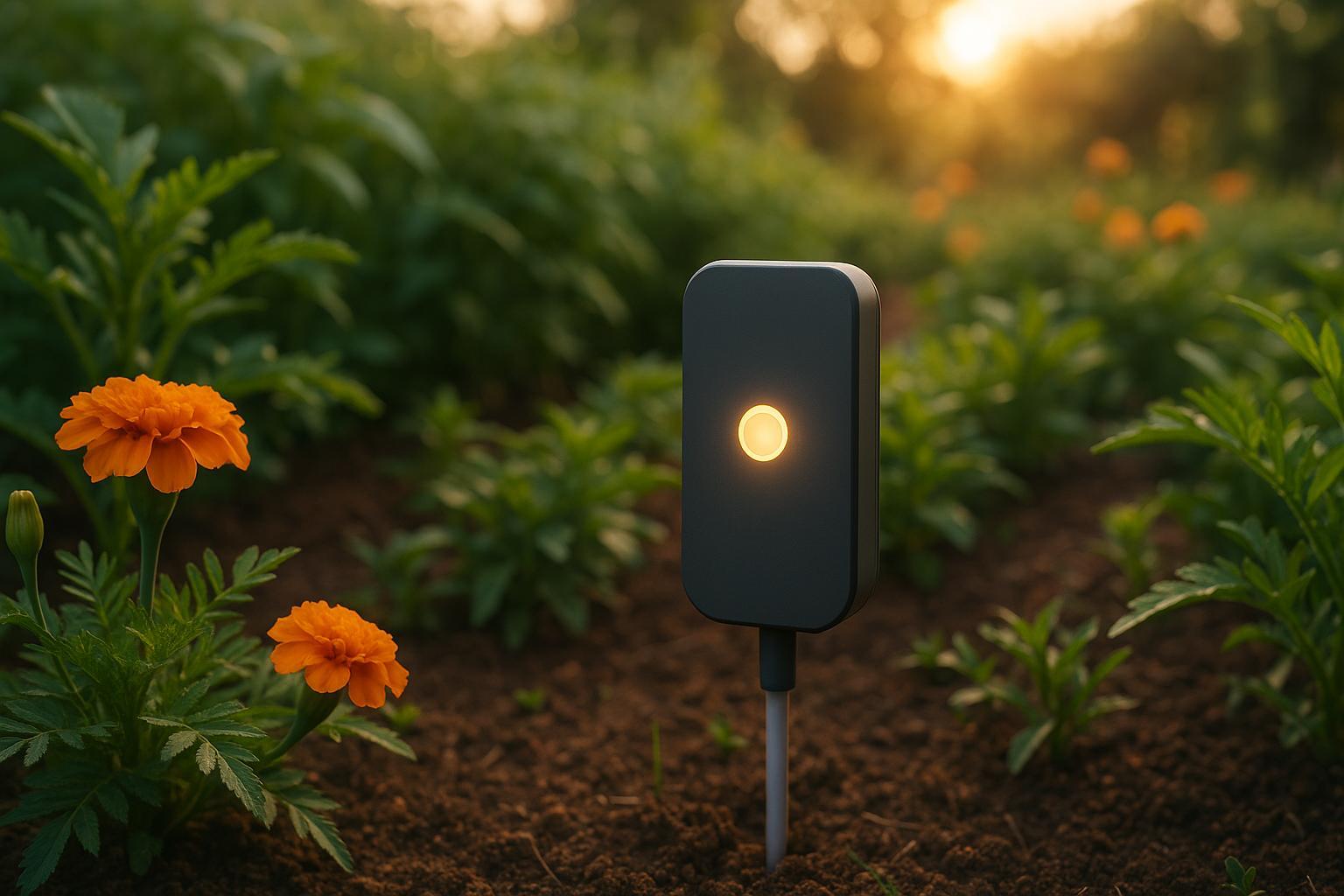
Checklist for Setting Up IoT Pest Sensors
Learn how to effectively set up IoT pest sensors in your garden, from choosing the right devices to ensuring optimal performance.
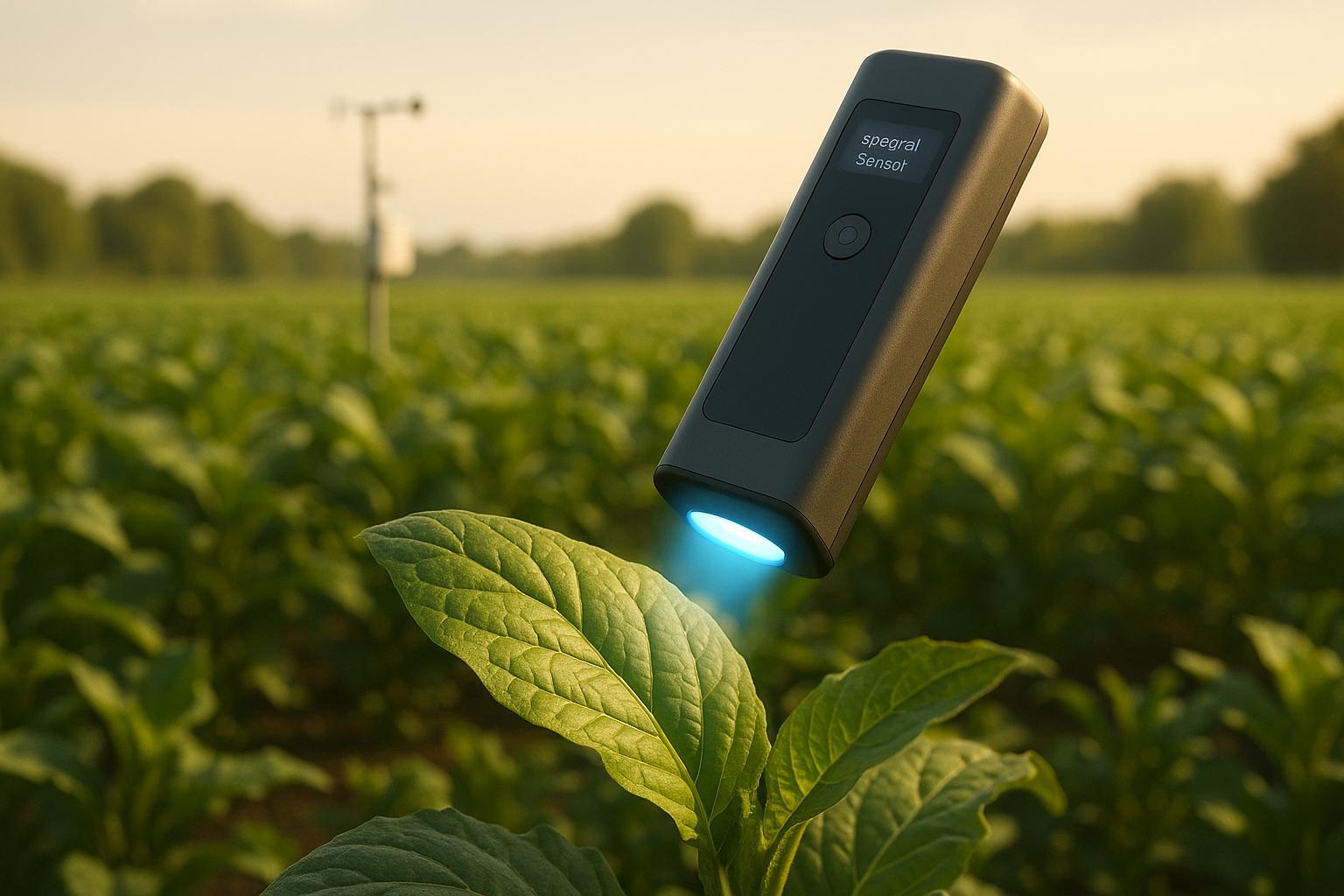
Data Fusion for Plant Disease Detection
Explore how data fusion combines spectral and environmental data to enhance plant disease detection, improving accuracy and early diagnosis.